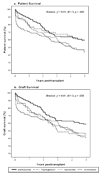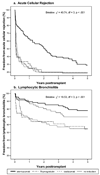Five-year outcomes with alemtuzumab induction after lung transplantation
- PMID: 21420318
- PMCID: PMC3110582
- DOI: 10.1016/j.healun.2011.01.714
Five-year outcomes with alemtuzumab induction after lung transplantation
Abstract
Background: Induction therapy with alemtuzumab, followed by lower than conventional intensity post-transplant immunosuppression (eg, tacrolimus monotherapy), has been associated with reduced morbidity and mortality in abdominal and heart transplantation. We examined 5-year outcomes in lung recipients receiving alemtuzumab in conjunction with reduced-intensity post-transplant immunosuppression (early lower-dose tacrolimus; lower-dose steroids, with or without mycophenolate mofetil), compared with lung recipients receiving other induction agents or no induction in association with post-transplant immunosuppression.
Methods: A retrospective analysis was performed using prospectively collected data from a single-site clinical database of 336 lung recipients (aged ≥ 18) who received allografts between 1998 and 2005, classified by induction type: alemtuzumab, 127; Thymoglobulin, 43; daclizumab, 73; and none, 93. Survival analyses examined patient and graft survival, and freedom from acute cellular rejection (ACR), lymphocytic bronchiolitis, obliterative bronchiolitis (OB), bronchiolitis obliterans syndrome (BOS), and post-transplant lymphoproliferative disorder (PTLD).
Results: Five-year patient and graft survival differed by group (p = 0.046, p = 0.038, respectively). Alemtuzumab patient/graft survival rates were 59%/59%. Survival rates were 60%/44% for Thymoglobulin, 47%/46% for no induction, and 44%/41% for daclizumab. Freedom from ACR, lymphocytic bronchiolitis, OB, and BOS differed by group (all values, p < 0.008); alemtuzumab recipients showed greater 5-year freedom from each outcome (30%/82%/86%/54%) than Thymoglobulin (20%/54%/62%/27%), daclizumab (19%/55%/70%/43%), and no-induction groups (18%/70%/69%/46%). The groups did not differ in PTLD rates (≥ 94% free of PTLD at 5 years; p = 0.864). Effects were unchanged after controlling for potential covariates.
Conclusions: Alemtuzumab induction may be associated with improved outcomes in lung transplantation. Randomized controlled trials are needed to establish any effects of this agent.
Copyright © 2011 International Society for Heart and Lung Transplantation. Published by Elsevier Inc. All rights reserved.
Figures




Similar articles
-
Early outcomes in human lung transplantation with Thymoglobulin or Campath-1H for recipient pretreatment followed by posttransplant tacrolimus near-monotherapy.J Thorac Cardiovasc Surg. 2005 Aug;130(2):528-37. doi: 10.1016/j.jtcvs.2004.09.040. J Thorac Cardiovasc Surg. 2005. PMID: 16077423 Free PMC article.
-
The Impact of Alemtuzumab and Basiliximab Induction on Patient Survival and Time to Bronchiolitis Obliterans Syndrome in Double Lung Transplantation Recipients.Am J Transplant. 2016 Aug;16(8):2334-41. doi: 10.1111/ajt.13739. Epub 2016 May 23. Am J Transplant. 2016. PMID: 26833657
-
Alemtuzumab in lung transplantation: an open-label, randomized, prospective single center study.Am J Transplant. 2014 Aug;14(8):1839-45. doi: 10.1111/ajt.12824. Epub 2014 Jul 10. Am J Transplant. 2014. PMID: 25039364 Clinical Trial.
-
Acute Cellular Rejection and Infection Rates in Alemtuzumab vs Traditional Induction Therapy Agents for Lung and Heart Transplantation: A Systematic Review and Meta-analysis.Transplant Proc. 2018 Dec;50(10):3723-3731. doi: 10.1016/j.transproceed.2018.08.044. Epub 2018 Sep 7. Transplant Proc. 2018. PMID: 30577263
-
The efficacy and safety of alemtuzumab and daclizumab versus antithymocyte globulin during organ transplantation: a meta-analysis.Transplant Proc. 2012 Dec;44(10):2955-60. doi: 10.1016/j.transproceed.2012.05.085. Transplant Proc. 2012. PMID: 23195005 Review.
Cited by
-
New frontiers in immunosuppression.J Thorac Dis. 2018 May;10(5):3141-3155. doi: 10.21037/jtd.2018.04.79. J Thorac Dis. 2018. PMID: 29997983 Free PMC article. Review.
-
Lymphoproliferative disorder in a lung transplant recipient.BMJ Case Rep. 2020 Mar 31;13(3):e234532. doi: 10.1136/bcr-2020-234532. BMJ Case Rep. 2020. PMID: 32234858 Free PMC article.
-
Lung transplant infection.Respirology. 2013 Jan;18(1):22-38. doi: 10.1111/j.1440-1843.2012.02196.x. Respirology. 2013. PMID: 22591266 Free PMC article. Review.
-
Induction and maintenance immunosuppression in lung transplantation.Indian J Thorac Cardiovasc Surg. 2022 Jul;38(Suppl 2):300-317. doi: 10.1007/s12055-021-01225-x. Epub 2021 Sep 17. Indian J Thorac Cardiovasc Surg. 2022. PMID: 35756950 Free PMC article. Review.
-
Immunosuppression and allograft rejection following lung transplantation: evidence to date.Drugs. 2013 Nov;73(16):1793-813. doi: 10.1007/s40265-013-0136-x. Drugs. 2013. PMID: 24142409 Review.
References
-
- Christie JD, Edwards LB, Kucheryavaya AY, et al. The Registry of the International Society for Heart and Lung Transplantation: Twenty-seventh official adult lung and heart-lung transplantation report—2010. J Heart Lung Transplant. 2010;29:1104–1118. - PubMed
-
- McCurry KR, Shearon TH, Edwards LB, et al. Lung transplantation in the United States, 1998–2007. Am J Transplant. 2009;9:942–958. - PubMed
-
- Yusen RD, Shearon TH, Qian Y, et al. Lung transplantation in the United States, 1999–2008. Am J Transplant. 2010;10:1047–1068. - PubMed
-
- Organ Procurement and Transplantation Network and the Scientific Registry of Transplant Recipients: 2009 Annual Report, Transplant Data 1999–2008. Department of Health and Human Services, Health Resources and Services Administration, Healthcare Systems Bureau, Division of Transplantation, Rockville, MD; United Network for Organ Sharing, Richmond, VA; University Renal Research and Education Association, Ann Arbor, MI. [Last accessed, November 10, 2010]. http://optn.transplant.hrsa.gov.
-
- Hachem RR. Lung allograft rejection: diagnosis and management. Curr Opin Organ Transplant. 2009;14:477–482. - PubMed
Publication types
MeSH terms
Substances
Grants and funding
LinkOut - more resources
Full Text Sources
Medical
Miscellaneous

